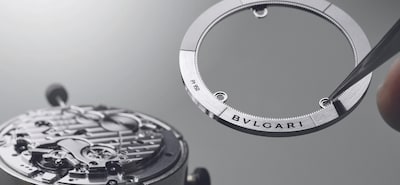Bulgari Brings its World-Beating Watches to the City of London
By Tracey Llewellyn | 5 minute read

With a client list that read like a Who’s Who of la dolce vita, the 1960s and 1970s established Bulgari as one of the leading celebrity jewellery houses of the 20th-century. At that time, its watches were made to complement the gem-set pieces, with movements manufactured by external partners. But in the late 1990s, all that changed. With a long-term plan in place, Bulgari bought the established and lauded brands Daniel Roth and Gérald Genta and acquired their Le Sentier manufacture, beginning a steep horological learning curve. Within a decade, these assets provided Bulgari with the means and the know-how to cross over into the realms of haute horlogerie, bursting the boundaries of what was previously thought of as achievable.
Industry recognition for Bulgari watchmaking was fast and copious, and the house has received close to 60 awards for horology since 2010. Already sell-out hits in the brand’s boutiques around the world, the timepieces are now being brought to the attention of a wider UK audience via an exclusive pop-up at Watches of Switzerland’s new 530m2 store in London’s Broadgate. Running through to 30 Novem-ber 2021, the pop-up occupies two storeys and includes a takeover of the first floor showcases and entrance towers, highlighting selected pieces from Bulgari’s two signature ranges for men and wom-en: the Octo and the Serpenti – collections that epitomise the master craftsmanship that the house is renowned for.
A total breakout from market trends, at the time of the Octo’s 2012 launch, 90 per cent of all watches sold came in round cases. Unsurprisingly, Bulgari’s new angular, octagonal timepiece was a considerable talking point, with some loving the bold reinvention of a classic, while others ques-tioned the wisdom of such a dramatic departure from the conventional. Bulgari, however, refused to be diverted from its goal, and since the debut of the Octo L’Originale, the model has developed into a comprehensive watch family that includes the gently curved and classic – at least as classic as Bul-gari’s audaciously Italian design ethic will allow – Octo Roma, and the game-changing Octo Finissi-mo.

Unlike its predecessor, the ultra-slim Finissimo was an instant and universal hit when it launched in 2014. The watch famed for its architectural case and integrated bracelet, has since become the fami-ly’s poster child, breaking six world records for achievements in micro technology – from the thinnest self-winding watch through to the slimmest flying tourbillon, minute repeater and perpetual calendar –earning scores of accolades along the way, including three Grand Prix de Horlogerie Genevé \(GPHG\) awards.
Beyond its mould-breaking aesthetic, the Finissimo has also enabled Bulgari to experiment with materials. Original models focused on a monochromatic palette involving titanium, carbon, ceramic, gold and steel finished with innovative polishing and micro-blasting techniques that emphasised the 110 facets of every case. The Watches of Switzerland pop-up will include exceptional, complicated versions of the Octo Finissimo including the titanium Chronograph GMT and the openwork Tourbillon Squelette. In addition, there will be the opportunity to see new models, including fresh takes on the sporty Finissimo S Steel, which introduce more colour and contrast to the range, while bringing a greater water resistance \(100m as opposed to the previous 30m\) thanks to the new screw-down crown.
Joining the Ottos at Broadgate will be current models from one of Bulgari’s most enduring – and recognisable – watch families: the Serpenti, which has graced the wrists of A-list women for more than 70 years. It was during the 1950s that the success of the Cinecittà film studios brought Holly-wood royalty including Rita Hayworth, Anita Ekberg and Audrey Hepburn to Rome and the door of Bulgari’s Via del Condotti boutique and the leader of the maison’s fan club, Elizabeth Taylor took the Serpenti to the attention of the world, when she was famously photographed wearing her own double-coiled version – one of four that she owned in her lifetime – on the set of Cleopatra \(1963\).

An ancient and universal symbol of regeneration, the snake has been a long-time signature of Bulgari but, far from remaining static, the Serpenti is constantly reinvented. Its origins lie in the late-1940s with the Tubogas – a minimalist watch design based on the flexible metal tubes used for gas pipes. Practical and affordable, the Tubogas was also innovative and modern, each piece being handmade and unique in size and dial shape. During the 1950s, the abstract Tubogas gradually evolved into a more distinct snake form with a serpent head hiding a watch dial beneath and, by the 1960s, a new flamboyant Serpenti had emerged, formed in gold and enrobed in enamel and gemstones.
Rare and coveted, the Serpentis of the past are highly prized, as are each of the new iterations of the watch, from the Incantati, where the coiled snake becomes the bezel, to the Seduttori whose bracelet consists of elongated ‘scales’, the modular Spiga with repeated wheat motif and the reimag-ined Tubogas models that unite the original 1940s designs with more recent serpents’ head dials. Central to the watches on display in Broadgate will be the 2021 steel Serpenti Tubogas with black lacquered dial and the double-coiled, full-pavé, white-gold Serpenti-Scaglie.
Running through to 30 November, the Bulgari pop-up can be visited at Watches of Swit-zerland, 100 Liverpool Street, London EC2M 2AU. For the duration of the pop-up, Bulgari’s timepiec-es can also be found on the Watches of Switzerland, Mappin & Webb and Goldsmiths web-sites.